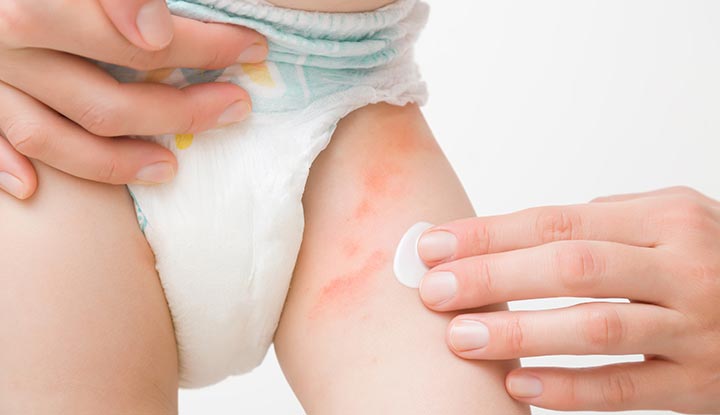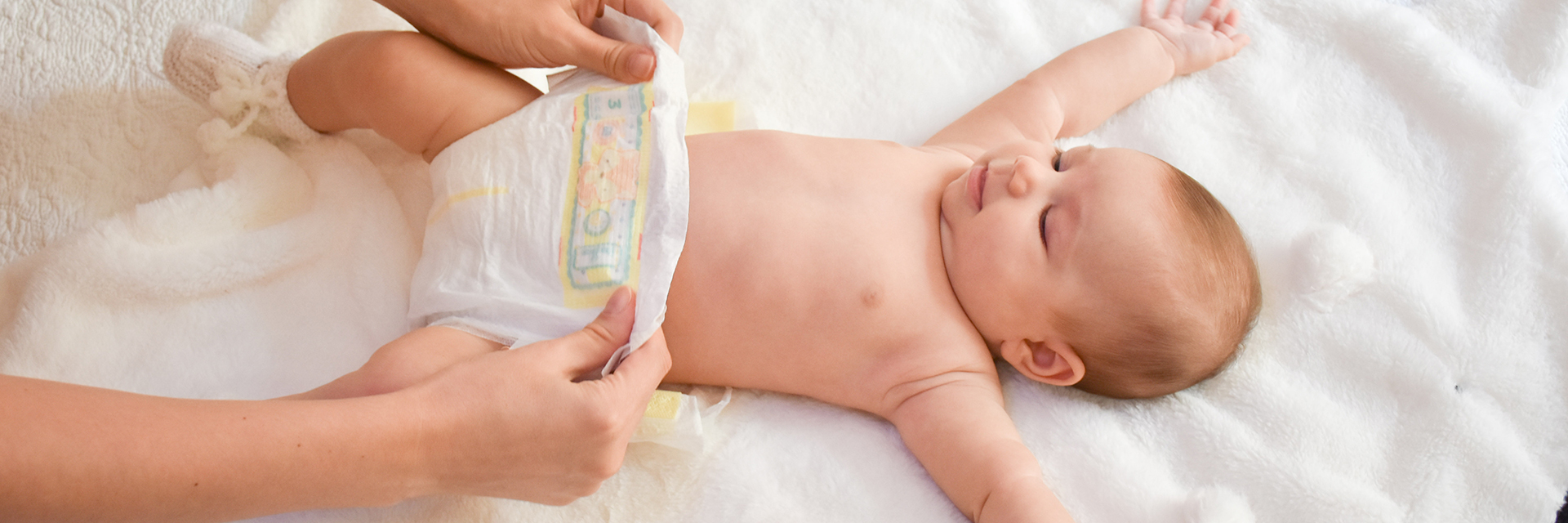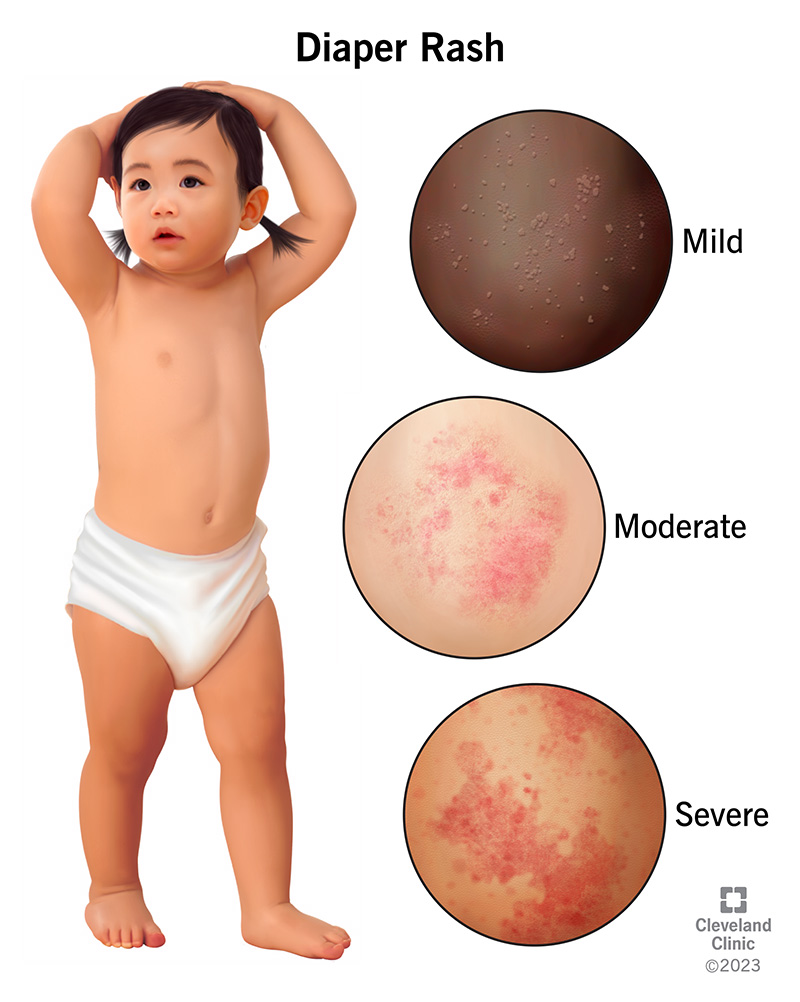Baby diaper rash is a common skin irritation caused by prolonged exposure to moisture. Yeast infection is a fungal infection often appearing in warm, moist areas.
Parents often face the challenge of distinguishing between baby diaper rash and yeast infection. Diaper rash typically results from prolonged exposure to wet or dirty diapers, causing red, irritated skin. Yeast infections, on the other hand, manifest as red, raised, and often shiny patches, frequently accompanied by satellite lesions.
Recognizing the difference is crucial for effective treatment. Diaper rash usually improves with frequent diaper changes and barrier creams. Yeast infections may require antifungal medication. Understanding these conditions helps parents manage and alleviate their baby’s discomfort effectively.
Causes
Understanding the causes of diaper rash and yeast infection can help parents prevent these issues. Both conditions can cause discomfort for babies. Let’s explore the common causes of each.
Common Causes Of Diaper Rash
Diaper rash is a frequent problem for babies. Here are some common causes:
- Wet Diapers: Prolonged exposure to wet diapers irritates the skin.
- Friction: Rubbing from tight diapers can cause rashes.
- Chemical Sensitivity: Baby wipes or detergents can irritate sensitive skin.
- Introduction of New Foods: New foods can change stool acidity, causing rashes.
- Antibiotics: Antibiotics can kill healthy bacteria, leading to rashes.
Common Causes Of Yeast Infection
Yeast infections in babies are also common. Here are the typical causes:
- Moist Environment: Yeast thrives in warm, moist areas like diaper regions.
- Antibiotic Use: Antibiotics can disrupt the balance of bacteria and yeast.
- Immune System: A weakened immune system can lead to yeast overgrowth.
- Diabetes: High sugar levels can promote yeast growth.
| Cause | Diaper Rash | Yeast Infection |
|---|---|---|
| Wet Diapers | Yes | No |
| Friction | Yes | No |
| Chemical Sensitivity | Yes | No |
| New Foods | Yes | No |
| Antibiotics | Yes | Yes |
| Moist Environment | No | Yes |
| Immune System | No | Yes |
| Diabetes | No | Yes |

Credit: my.clevelandclinic.org
Symptoms
Parents often confuse diaper rash with a yeast infection. Recognizing the symptoms can help in choosing the right treatment. Let’s explore the distinct signs of each condition.
Diaper Rash Symptoms
Diaper rash usually presents as red, inflamed skin in the diaper area. Common symptoms include:
- Red patches on the buttocks.
- Swollen or warm skin.
- Discomfort or fussiness during diaper changes.
In severe cases, you might see:
- Blisters or open sores.
- Peeling skin.
Diaper rash is often caused by prolonged exposure to wetness or friction.
Yeast Infection Symptoms
A yeast infection is more intense than a regular diaper rash. Look for these symptoms:
- Bright red rash with raised borders.
- Small red bumps or pimples.
- Rash spreading to the thigh and stomach.
Yeast infections can cause a lot of discomfort. You might notice:
- White scales or flakes on the skin.
- Cracked or oozing skin.
- Constant crying and irritability.
Yeast infections thrive in warm, moist environments. They often appear after antibiotic use.
Visual Differences
Baby diaper rash and yeast infection often confuse parents. Knowing the visual differences can help you identify and treat them correctly.
Appearance Of Diaper Rash
Diaper rash is a common skin irritation. It appears as red, inflamed skin in the diaper area. Here are some key features:
- Red patches: These are usually flat and may cover large areas.
- Dry skin: The affected area may look dry and flaky.
- Blisters: Small, raised bumps may appear.
- Swelling: The skin may appear swollen and tender.
This condition often improves with regular diaper changes and barrier creams.
Appearance Of Yeast Infection
A yeast infection is a fungal infection. It often develops in moist, warm areas. The visual clues are different from a diaper rash:
- Bright red patches: These patches are more intense in color.
- Raised edges: The rash often has well-defined, raised edges.
- Satellite lesions: Small red bumps or pustules may spread beyond the main rash.
- Shiny skin: The affected skin may appear shiny and smooth.
Yeast infections need antifungal treatments for effective relief.
| Symptom | Diaper Rash | Yeast Infection |
|---|---|---|
| Color | Red | Bright Red |
| Texture | Dry and Flaky | Shiny |
| Edges | Flat | Raised |
| Additional Signs | Blisters | Satellite Lesions |
Diagnosis
Diagnosing a baby diaper rash versus a yeast infection requires careful assessment. Parents often struggle to differentiate between the two. Doctors use specific methods to identify the cause. Understanding these methods can help in managing the condition effectively.
Clinical Examination
Doctors first perform a clinical examination. They look at the rash’s appearance. Diaper rashes are usually red and inflamed. They may have small bumps or spots. Yeast infections, on the other hand, appear bright red. They often have raised edges and satellite lesions.
Doctors may also ask about symptoms. For example, does the baby seem more uncomfortable or in pain? Yeast infections can cause more intense discomfort. They may also occur in skin folds, unlike typical diaper rashes.
Laboratory Tests
Sometimes, a clinical examination is not enough. Doctors may need to perform laboratory tests. These tests help confirm the presence of yeast. One common test is a skin scraping. The doctor gently scrapes a small sample from the rash. This sample is then examined under a microscope.
Another test is a culture test. The doctor takes a swab from the affected area. This swab is sent to a lab to grow and identify any yeast or bacteria. Results usually take a few days. These tests help ensure the correct diagnosis.
Laboratory tests are crucial for persistent or severe rashes. They help in prescribing the right treatment. Proper diagnosis leads to faster relief for the baby.
Treatment Options
Parents often worry about diaper rashes and yeast infections. Knowing the right treatment is crucial. Both conditions need different care methods. Below are the best treatment options for each.
Treating Diaper Rash
Diaper rash is a common issue in infants. It can cause discomfort and irritation. Here are effective ways to treat it:
- Frequent Diaper Changes: Change diapers often. Keep the area dry and clean.
- Gentle Cleaning: Use mild soap and water. Avoid wipes with alcohol or fragrance.
- Diaper-Free Time: Allow the baby to go without a diaper for some time. This helps the skin breathe.
- Barrier Creams: Apply zinc oxide or petroleum jelly. They protect the skin from moisture.
| Treatment | Description |
|---|---|
| Frequent Diaper Changes | Keep the area dry by changing diapers regularly. |
| Gentle Cleaning | Use mild soap and water for cleaning. |
| Diaper-Free Time | Allow the skin to breathe without a diaper. |
| Barrier Creams | Use zinc oxide or petroleum jelly to protect the skin. |
Treating Yeast Infection
A yeast infection in the diaper area needs different care. It is often caused by the fungus Candida. Here are the steps to treat it:
- Antifungal Creams: Use creams like clotrimazole or miconazole. Apply as directed by a doctor.
- Keep Area Dry: Moisture worsens yeast infections. Keep the area dry.
- Avoid Irritants: Do not use scented wipes or soaps.
- Consult a Doctor: Always consult a healthcare provider for proper diagnosis and treatment.
Using these methods helps in treating yeast infections effectively. Make sure to follow each step carefully for the best results.
Prevention Strategies
Keeping your baby’s skin healthy is vital. Preventing diaper rash and yeast infection can save your baby from discomfort. Let’s explore some practical strategies.
Preventing Diaper Rash
Diaper rash is common but preventable. Follow these steps to keep your baby’s skin smooth and rash-free.
- Change diapers often: A wet or dirty diaper can cause irritation. Change it every 2-3 hours.
- Use gentle wipes: Choose alcohol-free wipes. They are gentler on your baby’s skin.
- Let the skin breathe: Give your baby some diaper-free time. Fresh air can help prevent rashes.
- Apply barrier cream: Use a zinc oxide cream. It can protect your baby’s skin from moisture.
- Choose the right diaper size: A well-fitting diaper prevents friction. Make sure it’s not too tight or too loose.
Preventing Yeast Infection
Yeast infections are uncomfortable for babies. These tips can help you prevent them effectively.
- Keep the area dry: Yeast thrives in moisture. Ensure the diaper area is dry before putting on a new diaper.
- Change diapers immediately: Do not wait if the diaper is soiled. Quick changes reduce the risk of yeast growth.
- Avoid tight diapers: Tight diapers can create a warm, moist environment. Opt for breathable, well-fitting diapers.
- Use antifungal cream: If your baby is prone to yeast infections, apply an antifungal cream as a precaution.
- Wash hands thoroughly: Always wash your hands before and after diaper changes. This prevents the spread of yeast.
| Prevention Tips | Diaper Rash | Yeast Infection |
|---|---|---|
| Change diapers frequently | ✔️ | ✔️ |
| Use gentle wipes | ✔️ | ✔️ |
| Let skin breathe | ✔️ | ✔️ |
| Apply barrier cream | ✔️ | |
| Use antifungal cream | ✔️ | |
| Wash hands thoroughly | ✔️ | ✔️ |
When To See A Doctor
Understanding whether your baby has a diaper rash or a yeast infection is crucial. In some cases, home treatments might not be enough. Knowing when to see a doctor can save your baby discomfort and help you find the right treatment.
Warning Signs
Be alert to certain warning signs that indicate a need for medical attention. If the rash:
- Lasts more than a few days despite home treatment
- Is accompanied by a fever
- Has blisters, pus-filled sores, or open wounds
- Spreads beyond the diaper area
- Causes your baby severe discomfort or pain
These symptoms suggest that the condition might be more severe than a regular diaper rash. In such cases, a doctor’s consultation is essential.
Consultation Tips
When visiting the doctor, prepare the following consultation tips to ensure a thorough evaluation:
- Note the duration of the rash and any treatments tried.
- Describe the appearance of the rash (color, size, and location).
- Mention if your baby has been taking any medications.
- Discuss any other symptoms like fever or irritability.
- Bring along any creams or ointments you have used.
These steps help the doctor diagnose the issue accurately and recommend the best treatment.
| Symptom | Diaper Rash | Yeast Infection |
|---|---|---|
| Appearance | Red, inflamed skin | Bright red with raised edges |
| Location | Confined to diaper area | May spread to folds of skin |
| Duration | Improves within days | Persists without treatment |
Understanding these differences can aid in identifying the condition early and seeking appropriate care.

Credit: themomcentre.com

Credit: www.texashealth.org
Frequently Asked Questions
What Causes Diaper Rash In Babies?
Diaper rash is usually caused by prolonged exposure to wet diapers. It can also result from friction, sensitive skin, or irritants like soaps and wipes.
How To Tell If It’s A Yeast Infection?
A yeast infection often appears as bright red patches. It might have raised edges and small red spots nearby. Unlike diaper rash, it doesn’t improve with standard diaper creams.
Can A Yeast Infection Spread?
Yes, a yeast infection can spread. It may affect other areas like the mouth, known as thrush. Quick treatment is essential.
How To Prevent Diaper Rash?
To prevent diaper rash, change diapers frequently. Use gentle wipes and apply barrier creams. Allow the baby’s skin to air out regularly.
Conclusion
Understanding the differences between baby diaper rash and yeast infection is crucial for proper treatment. Always consult a pediatrician for accurate diagnosis and advice. Proper hygiene and timely intervention can prevent complications. Your baby’s comfort and health are paramount, so stay informed and proactive in managing skin issues.




